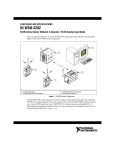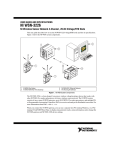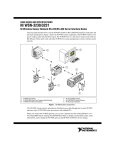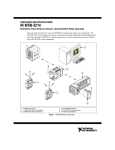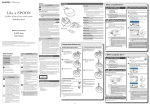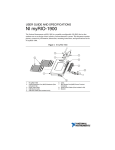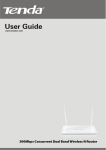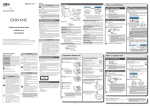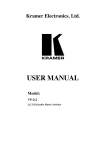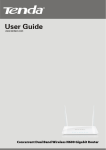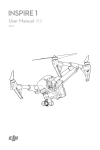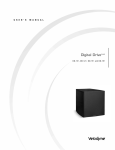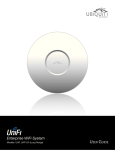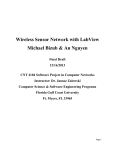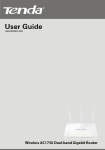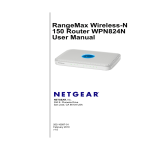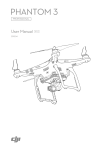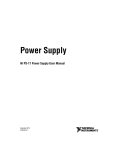Download NI WSN-3212 User Guide and Specifications
Transcript
USER GUIDE AND SPECIFICATIONS NI WSN-3212 NI Wireless Sensor Network 4-Channel, 24-Bit Thermocouple Input Node This user guide describes how to use the NI WSN-3212 thermocouple input node and lists its specifications. Figure 1 shows the NI WSN system components. 4 2 Or 1 3 1 1 2 NI WSN-32xx Nodes NI 9792 WSN Real-Time Gateway 3 4 NI WSN-9791 Ethernet Gateway PC Running NI Software Figure 1. NI WSN System Components The NI WSN-3212 is a four-channel, low-power, wireless thermocouple input device that works with other NI WSN-32xx nodes and gateways to form a wireless sensor network. The NI WSN system consists of one or more NI WSN gateways, up to 36 NI WSN-32xx nodes per gateway, and multiple PCs or Programmable Automation Controllers (PACs) to receive and analyze the distributed sensor data. For more information about PACs, visit ni.com. When you connect the NI WSN gateway, you can use a separate host PC running Windows, or a PAC running NI LabVIEW Real-Time, to display measurement results, status information, and to change the NI gateway and NI WSN-3212 device settings. Figure 2 shows the NI WSN-3212 device block diagram. Antenna Battery Input (Internal) External Power Input Power Supply and Selector 2.4 GHz 802.15.4 Radio Analog Front End Low-Power Microcontroller DIO Circuitry Flash 18-Position Combicon Connector Figure 2. NI WSN-3212 Device Block Diagram NI WSN-3212 User Guide and Specifications 2 ni.com Dimensions Figure 3 shows the NI WSN-3212 device dimensions. 235 mm (9.25 in.) 124 mm (4.88 in.) 55.9 mm (2.20 in.) 86.4 mm (3.40 in.) 42.4 mm (1.67 in.) 25.4 mm (1.00 in.) 50.8 mm (2.00 in.) Figure 3. NI WSN-3212 Device Dimensions Safety Guidelines Operate the NI WSN-3212 device only as described in this user guide. Hot Surface This icon denotes that the component may be hot. Touching this component may result in bodily injury. NI WSN Safety Information The following section contains important safety information that you must follow when installing and using NI WSN products. Caution Do not operate the NI WSN product in a manner not specified in the user manual or operating instructions. Product misuse can result in a hazard. You can compromise the safety protection built into the product if the product is damaged in any way. If the product is damaged, return it to National Instruments for repair. Caution Do not substitute parts or modify the NI WSN product. Use the product only with the devices, accessories, and cables specified in the installation instructions. Caution Do not operate NI WSN products in an explosive atmosphere or where there may be flammable gases or fumes. © National Instruments Corporation 3 NI WSN-3212 User Guide and Specifications Caution If you need to clean a NI WSN product, use a soft dry towel. The product must be completely dry and free from contaminants before you return it to service. Caution Operate the product indoors only at or below Pollution Degree 2. Pollution is foreign matter in a solid, liquid, or gaseous state that can reduce dielectric strength or surface resistivity. Caution You must insulate signal connections for the maximum voltage for which the NI WSN product is rated. Do not exceed the maximum ratings for the product. Do not install wiring while the product is live with electrical signals. Do not remove or add connector blocks when power is connected to the NI WSN system. Avoid contact between your body and the connector block signal wiring when hot-swapping devices. Caution To comply with safety regulations, use only recommended batteries with this product. Refer to the Battery Power section for the recommended battery types. Safety Guidelines for Hazardous Locations The NI WSN-3212 is suitable for use in Class I, Division 2, Groups A, B, C, D, T4 hazardous locations; Class I, Zone 2, AEx nC IIC T4 and Ex nL IIC T4 hazardous locations; and nonhazardous locations only. Follow these guidelines if you are installing the NI WSN-3212 in a potentially explosive environment. Not following these guidelines may result in serious injury or death. Caution Observe the battery manufacturers’ operating temperature ratings listed in the Battery operating temperature range specification section. Caution Do not disconnect the power supply wires and connectors from the de unless power has been switched off. Caution Do not install or remove the device unless power has been switched off. Caution Substitution of components may impair suitability for Class I, Division 2. Caution For Zone 2 applications, install the WSN system in an enclosure rated to at least IP 54 as defined by IEC 60529 and EN 60529. Special Conditions for Hazardous Locations Use in Europe The NI WSN-3212 has been evaluated as Ex nA nL IIC T4 equipment under DEMKO Certificate No. 07 ATEX 0626664X. Each device is marked II 3G and is suitable for use in Zone 2 hazardous locations, in ambient temperatures of –40 °C ≤ Ta ≤ 70 °C. Electromagnetic Compatibility Guidelines This product was tested and complies with the regulatory requirements and limits for electromagnetic compatibility (EMC) as stated in the product specifications. These requirements and limits are designed to provide reasonable protection against harmful interference when the product is operated in its intended operational electromagnetic environment. This product is intended for use in industrial locations. There is no guarantee that harmful interference will not occur in a particular installation, when the product is connected to a test object, or if the product is used in residential areas. To minimize the potential for the product to cause interference to radio and television reception or to experience unacceptable performance degradation, install and use this product in strict accordance with the instructions in the product documentation. NI WSN-3212 User Guide and Specifications 4 ni.com Furthermore, any changes or modifications to the product not expressly approved by National Instruments could void your authority to operate it under your local regulatory rules. The following statements contain important EMC information needed before installing and using this product Caution To ensure the specified EMC performance, product installation requires either special considerations or user-installed, add-on devices. See the product installation instructions for further information. Caution To ensure the specified EMC performance, operate this product only with shielded cables and accessories. Caution The inputs/outputs of this product can be damaged if subjected to Electrostatic Discharge (ESD). To prevent damage, industry-standard ESD prevention measures must be employed during installation, maintenance, and operation. Caution This product may become more sensitive to electromagnetic disturbances in the operational environment when test leads are attached or when connected to a test object. Related Documentation Check ni.com/manuals for the most recent documentation. For a complete list of documentation related to the NI WSN system, refer to ni.com/info and enter rdwsnrd. In addition to this guide, the following documents may be useful when configuring your NI WSN system: • NI Wireless Sensor Network Getting Started Guide • NI WSN-9791 Ethernet Gateway User Guide and Specifications • NI 9792 WSN Real-Time Gateway User Guide and Specifications • Configuring WSN in MAX, available from Start»All Programs»National Instruments»NI-WSN • LabVIEW Help for WSN Devices, available in LabVIEW from Help»LV Help» WSN Devices Help • NI-WSN Readme, available on the software installation disc included with your gateway. Training Courses If you need more help getting started developing an application with NI products, NI offers training courses. To enroll in a course or obtain a detailed course outline, refer to ni.com/training. Technical Support on the Web For additional support, refer to ni.com/support or zone.ni.com. © National Instruments Corporation 5 NI WSN-3212 User Guide and Specifications Software Overview Note Refer to the NI WSN Readme, available on the software installation disc included with your device, for NI software application version support. NI-WSN software includes NI Measurement & Automation Explorer (MAX) as well as server and driver software for easy integration into application software packages. These software component manage the low-level communications and hardware configurations, simplifying programmatic access to I/O channels. The NI-WSN software is on the software installation disc included with your NI WSN gateway device. The NI-WSN software is supported by Windows 7/Vista/XP and contains the following components: • NI MAX • NI-WSN You can download a current version of NI-WSN software from ni.com/support. Using your Web browser, go to ni.com/support and select Drivers and Updates»Distributed I/O»Wireless Sensor Networks, and then select the latest version of NI-WSN software. If you are using other software, refer to the installation instructions that accompany your software. What You Need to Get Started To set up and use NI LabVIEW with the NI WSN-3212 device, you need the following: • NI WSN gateway • NI WSN-32xx devices with a 9–30 V power supply or four AA 1.5 V alkaline batteries for each node. Refer to the Battery Power section for recommended batteries. • Mounting hardware (DIN rail, panel-mount, or rack mount accessory) • Ethernet cable/connection • 1/8 in. flathead and number 2 Phillips screwdrivers • NI-WSN software version 1.1 or later • Host PC running Windows 7/Vista/XP • NI LabVIEW 8.6.1 (32-bit) or later • (NI 9792 WSN Real-Time Gateway Only)—NI LabVIEW 2009 SP1 (32-bit) Real-Time Module or later • Related hardware and software documentation NI WSN-3212 User Guide and Specifications 6 ni.com Unpack the Device and Install the Antenna Remove the device from the package and inspect the device. Contact NI if the device appears damaged. Do not install a damaged device. Caution The device is static sensitive. Always properly ground yourself and the equipment when handling or connecting to the device. To attach the antenna, align the antenna with the mount and screw it on, as shown in Figure 4. Caution The antenna must be attached to the NI WSN devices in order for the NI WSN devices to function correctly. N INATIO ST N RU AL ME NT S NATIONAL INSTRUMENTS Figure 4. Attach the Antenna to the Device Mounting the NI WSN-3212 Device You can mount the NI WSN-3212 on a panel or on a 35 mm DIN rail. For kit accessory ordering information, refer to the NI WSN product page accessory section at ni.com. Before using any of these mounting methods, remove and save the serial number sticker located on the back of the NI WSN-3212 device for future use when configuring your device in software. For the NI WSN-3212 device dimensions, refer to Figure 3. Caution Your installation must allow 50.8 mm (2 in.) of clearance in front of devices for common connector cabling, such as the 18-terminal detachable screw terminal connector. Attaching the NI WSN-3282 DIN Rail (Optional) You can mount the NI WSN-3212 on a standard 35 mm DIN rail using a NI WSN-3282 DIN rail clip, NI part number 781074-01. Complete the following steps to mount the NI WSN-3212 on a DIN rail: Caution Power off the device before mounting it to the DIN rail. © National Instruments Corporation 7 NI WSN-3212 User Guide and Specifications Note Use thread-forming screws to permanently affix the DIN rail clip to the device. Unscrewing and reinstalling the thread-forming screws will produce a compromised connection between the DIN rail clip and the device. 1. Fasten the DIN rail clip to the NI WSN-3212 using a number 2 Phillips screwdriver and the four 8-32 × 5/16 in. thread-forming screws that shipped with the DIN rail clip(s). Figure 5 shows how to fasten the DIN rail clip to the NI WSN-3212. Caution Do not use screws longer than 5/16 in. to fasten the DIN rail clip to the NI WSN-3212. Figure 5. NI WSN-3212 Device DIN Rail Installation 2. Insert one edge of the DIN rail into the deeper opening of the DIN rail clip, as shown in Figure 6. 1 2 1 DIN Rail Clip (Without Device) 2 DIN Rail Figure 6. DIN Rail Clip Installation 3. Press down firmly on the NI WSN-3212 to compress the spring until the clip locks into place on the DIN rail. NI WSN-3212 User Guide and Specifications 8 ni.com Using a Panel Mount Accessory The NI WSN-3280/3281 panel mount accessories, part numbers 780999-01 and 781073-01, each include a retention clip and knob and integrated strain relief for power and I/O wires. You can use the NI WSN-3280 panel mount accessory to attach the NI WSN-3212 device to a panel or other flat surface. The NI WSN-3281 panel mount accessory also includes a magnetic mount for attaching the NI WSN-3212 device to metallic surfaces. Figure 7 shows the NI WSN-3212 panel mounting dimensions. 78.74 mm (3.100 in.) 44.02 mm (1.733 in.) 4.5 mm (5× Ø.177 in.) 55.88 mm (2.200 in.) 183.79 mm (7.236 in.) 53.34 mm (2.100 in.) 13.97 mm (0.550 in.) 25.40 mm (1.000 in.) 25.40 mm (1.000 in.) Figure 7. NI WSN-3212 Device Panel Mount Dimensions © National Instruments Corporation 9 NI WSN-3212 User Guide and Specifications 5 1 2 3 N INATIO ST N RU AL ME NT S 4 5 1 2 3 Retention Knob Retention Clip Mounting Hole 4 5 Integrated Mounting Pin Power and I/O Strain Relief Figure 8. Panel Mount Accessory Refer to Figure 8 while completing the following steps to mount the NI WSN-3212 on a panel: 1. (NI WSN-3280) Bolt or screw the panel mount accessory to a panel using five 8-32 or M4 screws. (NI WSN-3281) Attach the panel mount accessory using the integrated magnet. 2. Slide the NI WSN-3212 device into the panel mount accessory as shown in Figure 8. NI WSN-3212 User Guide and Specifications 10 ni.com 3. Slide the retention clip down and tighten the panel mount knob to secure the NI WSN-3212 device as shown in Figure 9. NATIONAL INSTRUMENTS NATIONAL INSTRUMENTS Figure 9. Slide Retention Clip Down and Tighten Panel Mount Knob 4. (Optional) Secure any I/O signal or power supply cabling to the panel mount accessory using a zip-tie and the integrated strain relief slots. © National Instruments Corporation 11 NI WSN-3212 User Guide and Specifications Using the Integrated Panel Mount Slots You can also mount the NI WSN-3212 to a panel using the integrated panel mount slots as shown in Figure 10. 1. Attach three number 8 or M4 pan head screws in the mounting panel leaving 0.1 in. space under the head of each screw. Refer to Figure 3 for the correct hole pattern and dimensions. 2. Slide the NI WSN-3212 device onto the panel. Note In this configuration, the NI WSN-3212 is held in place only by the weight of the device and the friction of the screw attachment. Use the DIN rail clip or panel mount accessories in high vibration environments. Figure 10. Integrated Panel Mount Slots Caution Disconnect power before removing the device from the panel. Setting Up the NI WSN-3212 Device The following sections discuss setting up the NI WSN-3212 for use. Installing the Software You must be an Administrator to install NI software and devices on your computer. Before connecting the hardware, install the following software in the following order: 1. NI LabVIEW, available at ni.com/support. 2. NI-WSN and NI MAX, which are included on the software installation disc included with your NI WSN gateway and are also available for download at ni.com/support. Note After installation of NI-WSN, the NI Wireless Sensor Network Getting Started Guide is available from Start»All Programs»National Instruments»NI-WSN. NI WSN-3212 User Guide and Specifications 12 ni.com Powering the NI WSN-3212 Device The NI WSN-3202 device can be powered on by either an external power supply or four AA alkaline batteries. Refer to the Specifications section for details about the input power and battery requirements. If both battery and external power are connected, the NI WSN-3212 functions from the external power input. The device is designed to provide battery backup in the event of loss of external power and will automatically switch to battery power when external power is lost. Installing Batteries To install batteries in the NI WSN-3212 device, complete the following steps: 1. Loosen the battery compartment retention screw and remove the compartment cover, as shown in Figure 11. 1 1 Battery Retention Screw Figure 11. NI WSN-3212 Battery Compartment Caution Using the incorrect battery type causes an explosion risk. Do not use rechargeable batteries. Refer to the Battery Replacement and Disposal section for information about how to dispose of used batteries. Note When using the NI WSN-3212 device on battery power, you should configure the device as an end node so that it sleeps most of the time. Running a device configured as a router mode from battery power greatly reduces the battery life. The device ships from the factory configured as an end node. For more information about how to switch the node from an end mode to a router mode, refer to Configuring WSN in MAX, available from Start»All Programs»National Instruments» NI-WSN. 2. Install four AA alkaline batteries in the device, making sure to install them with the correct polarity. Figure 13 shows the battery polarity markings inside the device battery compartment. 3. Reinstall the battery compartment cover and tighten the retention screw. © National Instruments Corporation 13 NI WSN-3212 User Guide and Specifications Connecting External Power to the NI WSN-3212 Device To connect an external power supply to the NI WSN-3212, complete the following steps: 1. Remove the 2-position mini-combicon plug from the device, loosening the retaining screws if necessary. Figure 12. 2-Position Mini-Combicon Plug 2. Connect the external power supply positive lead to the V terminal. 3. Connect the negative (common) lead to the C terminal. 4. Reinstall the 2-position mini-combicon plug in the device and tighten the retaining screws. Caution You must use a UL Listed ITE power supply marked LPS with the NI WSN-3212. The power supply must also meet any safety and compliance requirements for the country of use. NI WSN-3212 User Guide and Specifications 14 ni.com Device Interface Figure 13 shows the NI WSN-3212 device interface. 8 2 1 4 3 6 5 7 1 2 3 4 WSN Connect Button Signal Strength/Status LEDs User LED 9–30 V External Power Input 5 6 7 8 Reset Button Battery Slots/Polarity Indicators I/O Connector Antenna Figure 13. NI WSN-3212 Node Interface © National Instruments Corporation 15 NI WSN-3212 User Guide and Specifications Signal Strength/Status LED Indicators The NI WSN-3212 has four signal strength/status LED indicators, which flash twice before displaying signal strength information. Table 1 shows the status and signal strength LED patterns. Table 1. Signal Strength and Status LED State/Node Status LED Indication Mode Signal Strength— LEDS 1–4 blink twice and then display the signal strength for three seconds LED State LED Pattern LED 1–4 OFF Device Status Low Signal 1 2 3 4 LED 1 ON, LED 2–4 OFF Poor 1 2 3 4 LED 1–2 ON, LED 3–4 OFF Fair 1 2 3 4 LED 1–3 ON, LED 4 OFF Good 1 2 3 4 LED 1–4 ON Excellent 1 2 3 4 Status Indication Each LED 1–4 blinking in succession Searching for network 1 2 3 4 1 2 3 4 1 2 3 4 1 2 3 4 LED 1, 4 and 2, 3 alternate blinking Updating firmware 1 2 3 4 1 2 3 4 LED 1–4 continuously blinking NI WSN-3212 User Guide and Specifications 1 2 3 4 1 2 3 4 16 Error. Reboot device. If problem persists, reset device to factory default settings. Go to ni.com/ support for additional troubleshooting steps. ni.com WSN Connect Button Note Refer to your NI WSN gateway documentation for detailed instructions about how to connect a NI WSN-3212 to the NI WSN gateway. The NI WSN-3212 is equipped with a WSN connect button as shown in Figure 13. The button controls network connection and the LEDs, which display connection status. Pressing the WSN connect button results in the device responses shown in Table 2. Table 2. WSN Connect State/Device Status Current Device State Duration of Button Press Result Initial power on, not connected Any duration Node turns on and searches for an available network. Connected to a NI WSN-9791 <5 seconds Node blinks all four signal strength LEDs twice, and then displays the signal strength as shown in Table 1. ≥5 seconds Node leaves current network and searches for a new network. Reset Button The NI WSN-3212 is equipped with a reset button as shown in Figure 13. Pressing the reset button results in the following device responses: • When pressed for fewer than 5 seconds, the device reboots with the current configuration. • When pressed for 5 seconds or more, the device reboots into Factory Default Mode, which returns the device user configuration to the factory-set defaults. Using the NI WSN-3212 Device Analog Input Circuitry Terminals 0–7 on the 18-position screw terminal connector are analog input. The NI WSN-3212 channels share a common ground that is not isolated from other system parts. Each channel has some impedance between the TC+ and COM terminal and between the TC– and the COM terminal. Each channel is filtered, and then sampled by a 24-bit analog-to-digital converter (ADC). There is a current source between the TC+ and TC– terminals. If an open thermocouple is connected to the channel, the current source forces a full-scale voltage across the terminals. Refer to your software documentation for more information about detecting open thermocouples in software. TC+ 10 MΩ 10 MΩ TC– COM Input Open Filtered ADC Impedance Thermocouple Differential Detection Amplifier Current NI WSN-3212 Figure 14. Analog Input Circuitry for One Channel © National Instruments Corporation 17 NI WSN-3212 User Guide and Specifications Connecting Thermocouples Thermocouples attached to the NI WSN-3212 must be electrically isolated from the device digital I/O ground (D GND) and earth ground. Isolated Thermocouple Probe TC+ TC– D GND NI WSN-3212 Figure 15. Connecting an Isolated Thermocouple Probe In Figure 15, the thermocouple junction is isolated from the outer metal probe sheath and even though the sheath is earth grounded, the junction itself is isolated from earth ground. Many thermocouple product manufacturers refer to this as an ungrounded thermocouple. Connect the thermocouple positive lead to the TC+ terminal and the negative lead to the TC– terminal. Check the thermocouple documentation or wire spool to determine the polarity of each lead. If using shielded thermocouple wire with the shield not connected to earth ground, connect the shield to the COM terminal as shown in Figure 16. Shield TC+ TC– Thermocouple COM NI WSN-3212 Figure 16. Connecting an Ungrounded, Shielded Thermocouple Probe If the shield connects to earth ground, leave the shield disconnected from the NI WSN-3212. Caution Connecting a non-isolated, earth grounded thermocouple causes corrupted temperature measurements. Determining Temperature Measurement Accuracy and Minimizing Errors Temperature measurement errors depend, in part, on the thermocouple type, the temperature being measured, the thermocouple accuracy, and the cold-junction temperature. Figures 17 through 21 shows the typical and maximum errors for the different thermocouple types when used with the NI WSN-3212 over the full temperature range. The figures account for gain errors, offset errors, differential and integral nonlinearity, quantization errors, noise errors, and isothermal errors. The figures do not account for the thermocouple accuracy itself. Temperature gradients across the NI WSN-3212 terminals affect the NI WSN-3212 User Guide and Specifications 18 ni.com cold-junction temperature accuracy. For the best accuracy results, keep temperature gradients across NI WSN-3212 terminals to a minimum. Refer to the Minimizing Thermal Gradients section for more information. Measurement Error (˚C) 6 4 2 0 0 200 400 600 800 1000 1200 1400 1600 1800 Measured Temperature (˚C) Max, –40 to 70 ˚C Typ, –40 to 70 ˚C Figure 17. Type B Errors Measurement Error (˚C) 5 4 3 2 1 0 –200 –50 100 250 400 550 700 850 1000 1150 1300 Measured Temperature (˚C) Max, –40 to 70 ˚C Typ, –40 to 70 ˚C Figure 18. Type J and N Errors © National Instruments Corporation 19 NI WSN-3212 User Guide and Specifications Measurement Error (˚C) 5 4 3 2 1 0 –200 0 200 400 600 800 1000 1200 1400 Measured Temperature (˚C) Max, –40 to 70 ˚C Typ, –40 to 70 ˚C Figure 19. Type K Errors Measurement Error (˚C) 6 4 2 0 –200 0 200 400 600 800 1000 1200 1400 1600 1800 Measured Temperature (˚C) Max, –40 to 70 ˚C Typ, –40 to 70 ˚C Figure 20. Type R and S Errors NI WSN-3212 User Guide and Specifications 20 ni.com Measurement Error (˚C) 5 4 3 2 1 0 –200 0 200 400 600 800 1000 Measured Temperature (˚C) Max, –40 to 70 ˚C Typ, –40 to 70 ˚C Figure 21. Type T and E Errors Cold-Junction Temperature Measurement Accuracy Heat dissipated by adjacent heat sources can cause errors in thermocouple measurements by heating up the terminals so that they are at a different temperature than the cold-junction compensation sensor used to measure the cold junction. The thermal gradient generated across the terminals can cause the terminals of different channels to be at different temperatures, so the resulting measurement creates errors not only in absolute accuracy but also in the relative accuracy between channels. If the system is mounted as recommended in the WSN device user guides, the NI WSN-3212 accuracy specifications include the errors caused by the gradient across the device terminals. Minimizing Thermal Gradients To minimize these errors, follow these guidelines: • Use small-gauge thermocouple wire. Smaller wire transfers less heat to or from the measuring junction. • Run thermocouple wiring together near the screw-terminal connector to keep the wires at the same temperature. • Avoid running thermocouple wires near hot or cold objects. • Keep the ambient temperature of the device as stable as possible. • Minimize adjacent heat sources and airflow across the device. © National Instruments Corporation 21 NI WSN-3212 User Guide and Specifications Controlling Digital Inputs and Outputs The NI WSN-3212 device has four bi-directional digital I/O channels, and each channel supports four operational modes: Drive High Only, Drive Low Only, Drive High and Low, and Tristate. Use the Node Properties dialog box in the LabVIEW Project Explorer window to change DIO settings. DIO PWR High Side Switch DI (Internal) DIO.x Low Side Switch D GND NI WSN-3212 Figure 22. Simplified Circuit Diagram of One DIO Channel Terminals 9–17 are the DIO section on the 18-position screw terminal connector. Each DIO channel has a signal terminal (DIO.x) and a ground terminal (D GND). There is also a terminal for the positive terminal of DIO Power (DIO PWR), which is only required when one of the DIO channels is configured for sourcing output. There is an internal digital input terminal which reads the digital output current state or the value of DIO.x when configured for Tristate mode. The NI-WSN software controls the different modes of operation by turning on and off the high side and low side switches. You can connect a variety of industrial devices such as solenoids, relays, and indicators to the NI WSN-3212 device. Refer to the Specifications section to ensure compatibility. The Drive High Only and the Drive High and Low modes require an external power supply connected to the DIO PWR terminal. The following sections discuss how to configure the NI WSN-3212 device for different types of input and output and how to connect external devices to the NI WSN-3212 DIO terminals. Connecting Sourcing Digital Outputs You must connect an external power supply to the NI WSN-3212 to source digital outputs. This power supply provides the current for the devices you connect to the NI WSN-3212. Connect the power supply positive lead to DIO PWR terminal and the power supply negative lead to one of the D GND pins. The DIO PWR terminal on the NI WSN-3212 is internally connected to each digital channel. You can connect only one external voltage supply to the device. Refer to the Specifications section for information about the power supply voltage range. Note You must use 2-wire ferrules to create a secure connection when connecting more than one wire to a single terminal on the NI WSN-3212. You can connect sourcing digital outputs to the NI WSN-3212 in either Drive High Only Mode or Drive High and Low Mode. In either mode, connect the device to DIO.x and connect the device common to the D GND terminal closest to that DIO.x terminal. NI WSN-3212 User Guide and Specifications 22 ni.com Drive High Only Mode In Drive High Only Mode, the DIO.x terminal is driven to the voltage supplied to DIO PWR when you turn on the channel. Writing a digital value of 1 turns on the channel, and 0 turns off the channel. The channel is high impedance (refer to the Specifications section for more information about the maximum input current) when the channel is turned off (0). Use this mode for devices that require high side drive or a sourcing output. DIO PWR 0 High Side Switch 1 DI (Internal) DIO.x Device + External Power – Supply D GND NI WSN-3212 Figure 23. Connecting a Device to the NI WSN-3212 in Drive High Only Mode Drive High and Low Mode In Drive High and Low mode, the DIO.x terminal is driven to the voltage supplied to DIO PWR when you turn on the channel, and is driven to D GND when you turn off the channel. Writing a digital value of 1 turns on the channel, and 0 turns off the channel. DIO PWR 1 High Side Switch DI (Internal) 0 DIO.x 0 D GND 1 Device + External Power – Supply Low Side Switch NI WSN-3212 Figure 24. Connecting a Device to the NI WSN-3212 in Drive High and Low Mode © National Instruments Corporation 23 NI WSN-3212 User Guide and Specifications Connecting Sinking Digital Outputs Drive Low Only Mode In Drive Low Only mode, the DIO.x terminal is pulled to D GND when you turn on the channel. Writing a digital value of 0 turns on the channel, and 1 turns off the channel. The channel is high impedance when the channel is turned off (1). Use this mode for devices that require low side drive or a sinking output. DIO.x DI (Internal) Device + External Power – Supply 1 Low Side Switch 0 D GND NI WSN-3212 Figure 25. Connecting a Device to the NI WSN-3212 in Drive Low Only Mode Connecting Digital Inputs Tristate Mode Use this mode to configure the channel as digital input, or for contact to ground sensing, as shown in Figure 26. In Tristate mode, when DIO.x terminal is read, a weak pull-up resistor to internal 3.3 V is enabled for about 1 ms. DIO.x Contact Switch DI.x (Internal) D GND DIO.x TTL Signal DI.x (Internal) D GND DIO.x External + Power Supply – DI.x (Internal) D GND Device NI WSN-3212 Figure 26. Example of Using the NI WSN-3212 in Tristate Mode NI WSN-3212 User Guide and Specifications 24 ni.com Digital I/O Protection Each digital I/O channel has overcurrent protection specifically to prevent damage due to short circuit faults. Understanding Short Circuit Protection A short circuit fault at the DIO.x terminal may cause a resettable fuse internal to the digital I/O channel to increase in resistance preventing damage to the equipment. Whether the fuse increases in resistance depends on factors such as the current level, the temperature, and power supply voltage. High inrush currents that exist for a short time do not trip the fuse. Refer to the Specifications section for more information about the maximum continuous output current, short circuit behavior, and short circuit trip time. Preventing an Overcurrent Condition Follow these recommendations to prevent an overcurrent condition: • Do not connect DIO PWR to ground. • Do not ground unused terminals. • Do not exceed the output current rating of the channel. Detecting a Overcurrent Condition If the node has detected an overcurrent condition, it immediately stops driving the DIO line, goes to a safe power down state, and blinks a four blink error code. The node must be manually reset or power-cycled to resume operation. A DIO line can be in overcurrent if it is driving high, or driving low, but not if it is tristated. To identify which DIO line tripped the overcurrent protection, set all the DIO lines to tristate and one by one set them to the desired drive mode and value until the protection is tripped. Resetting Channels After an Overcurrent Condition After you have identified and removed the cause of the overcurrent condition, to resume normal operation, you must reset the node by pressing the RESET button or by removing and reapplying power to the node. © National Instruments Corporation 25 NI WSN-3212 User Guide and Specifications NI WSN-3212 Device Pinout TC0+ 0 1 2 3 4 5 6 7 8 9 10 11 12 13 14 15 16 17 TC0– TC1+ TC1– TC2+ TC2– TC3+ TC3– COM DIO 0 D GND DIO 1 D GND DIO 2 D GND DIO 3 D GND DIO PWR Figure 27. NI WSN-3212 Pinout Specifications These specifications are typical from –40 to 70 °C unless otherwise noted. For the NI WSN gateway specifications, refer to the gateway documentation. Analog Input Characteristics Number of channels ...............................................4, thermocouple input ADC resolution ......................................................24 bits Type of ADC..........................................................Delta-Sigma Voltage measurement range ...................................±73 mV Common-mode range Channel-to-common ......................................±700 mV Common-mode rejection ratio (0 to 60 Hz) Channel-to-common ......................................95 dB Temperature measurement ranges Thermocouple types J, K, R, S, T, N, and B ............................................Works over temperature ranges defined by NIST Thermocouple type E.....................................–270 to 950 °C NI WSN-3212 User Guide and Specifications 26 ni.com Minimum sample interval ......................................2 s Input bandwidth (–3 dB)........................................1 Hz Noise rejection .......................................................65 dB minimum at 50/60 Hz Overvoltage protection...........................................±30 V between any input and common Differential input impedance .................................20 MΩ Input current...........................................................50 nA Input noise .............................................................0.5 µVrms Gain error...............................................................0.02% maximum at 25 °C, 0.03% typical at –40 to 70 °C, 0.1% maximum at –40 to 70 °C Offset error (with autozero) ...................................11 µV typical at –40 to 70 °C, 12.5 µV maximum –40 to 70 °C Digital I/O Number of channels ...............................................4 Modes (per channel) ..............................................Bi-directional Modes (configurable per channel) .........................Drive High Only, Drive Low Only, Drive High and Low, and Tristate Power-on output state.............................................High Impedance, Tristate DIO power supply voltage range (VDIO_PWR) ........5 to 30 V Digital Input (Tristate Mode) Input voltage range ................................................0 to 30 V Input logical levels High level input voltage .................................1.7 to 30 V Low level input voltage..................................0 to 0.45 V Input current (0 to 30 V) ........................................–160 µA to 400 µA maximum Contact to ground detection Contact close resistance (to ground)..............<2.5 KΩ Contact open resistance (to ground) ..............>40 KΩ Contact capacitance ...............................................<20 nF Digital Output Total DIO current (all channels) ............................0.5 A maximum Output current (one channel) (IOUT) ......................0.5 A maximum Output voltage Sourcing .........................................................VDIO PWR – 0.5 V – (0.9 Ω × IOUT) minimum Sinking ...........................................................0.9 Ω × IOUT maximum © National Instruments Corporation 27 NI WSN-3212 User Guide and Specifications Protection Voltage ...........................................................30 VDC maximum Reversed voltage ............................................30 VDC maximum Short circuit Trip current ............................................0.57 A minimum, 3.5 A maximum Trip time.................................................2.5 s at 5 A typical at 25 °C Switching time Sinking, 10 KΩ pull-up .................................15 µs Sourcing, 10 KΩ pull-down...........................3.5 ms Node Resources for LabVIEW WSN User flash size ........................................................248 Kbytes Number of flash erase cycles per sector ................100,000 Wireless Characteristics Radio mode ............................................................IEEE 802.15.4 RF data rate............................................................250 kbit/s Frequency band1 ....................................................ISM 2.4 GHz (2400 MHz to 2483.5 MHz) Channels2 ...............................................................11–24 TX power Americas ........................................................+17 db (50 mW) International ...................................................+10 db (10 mW) Range Americas ........................................................Up to 300 m International ...................................................Up to 150 m Modulation type.....................................................DSSS (O-QPSK) Receiver sensitivity ................................................–102 dBm Antenna Connector.......................................................Female RP-SMA connector VSWR............................................................MAX.2.0 Impedance ......................................................50 Ω Directivity ......................................................Omni Nominal gain..................................................1.5 dBi 1 2 Due to regulations, the frequency bands depend upon country of operation. Due to regulations, the valid channels depend upon country of operation. NI WSN-3212 User Guide and Specifications 28 ni.com Power Requirements The power requirements specifications are typical at 25 °C. Battery Power Caution Do not use rechargeable batteries. Internal battery.......................................................4 AA 1.5 V alkaline only Recommended batteries.........................................Energizer EN 91 AA, alkaline Duracell MN1500 AA, alkaline Battery operating temperature range Energizer E91.........................................–18 °C to 55 °C Duracell MN1500 ..................................–20 °C to 54 °C Voltage range .........................................................3.6 to 7.5 V Power consumption1 60 second sample interval..............................0.4 mW at 6 V 2 second sample interval................................7.4 mW at 6 V Battery life1 60 second sample interval..............................Up to 3 years 2 second sample interval................................Up to 2 months External Power Caution You must use a UL Listed ITE power supply marked LPS with the NI WSN-3212. The power supply must also meet any safety and compliance requirements for the country of use. Voltage range .........................................................9 to 30 V Power input mating connector ...............................2-position mini-combicon, Phoenix Contact part number: 1714977 Power consumption End node mode 60 second sample interval......................15 mW at 24 V 2 second sample interval........................25 mW at 24 V Router mode2 .................................................300 mW at 24 V Physical Characteristics Screw-terminal wiring ...........................................14 to 24 AWG wire Torque for screw terminals ....................................0.2 to 0.25 N · m Dimensions ............................................................Refer to Figure 3 for device dimensions Weight ....................................................................Approximately 242 g (8.5 oz) Weight with antenna .............................................Approximately 256 g (9 oz) 1 2 Device executing NI-WSN firmware. End node mode. Router connected directly to gateway. Routing messages for one end node at a one minute sample interval. © National Instruments Corporation 29 NI WSN-3212 User Guide and Specifications Calibration You can obtain the calibration certificate and information about calibration services for the NI WSN-3212 at ni.com/calibration. The NI WSN-3212 Calibration Procedure is available from ni.com/manuals. Calibration interval ................................................3 years Safety Standards Note For UL and other safety certifications, refer to the product label, or go to ni.com/ certification, search by model number or product line, and click the appropriate link in the Certification column. The NI WSN-3212 is designed to meet the requirements of the following standards of safety for electrical equipment for measurement, control, and laboratory use: • IEC 61010-1, EN 61010-1 • UL 61010-1, CSA 61010-1 Hazardous Locations U.S. (UL) ...............................................................Class I, Division 2, Groups A, B, C, D, T4; Class I, Zone 2, AEx nC IIC T4 Canada (C-UL) ......................................................Class I, Division 2, Groups A, B, C, D, T4; Class I, Zone 2, Ex nL IIC T4 Europe (DEMKO)..................................................Ex nA nL IIC T4 Safety Voltages Connect only voltages that are within these limits. V terminal to C terminal ........................................30 V max, Measurement Category I Measurement Category I is for measurements performed on circuits not directly connected to the electrical distribution system referred to as MAINS voltage. MAINS is a hazardous live electrical supply system that powers equipment. This category is for measurements of voltages from specially protected secondary circuits. Such voltage measurements include signal levels, special equipment, limited-energy parts of equipment, circuits powered by regulated low-voltage sources, and electronics. Caution Do not connect the system to signals or use for measurements within Measurement Categories II, III, or IV. RF Safety Warning This product complies with FCC radiation exposure limits set for uncontrolled equipment and meets the FCC radio frequency (RF) Exposure Guidelines in Supplement C to OET65. This product generates and radiates radio frequency energy. To comply with the radio frequency radiation exposure guidelines in an uncontrolled environment, this equipment should be installed and operated with at least 20 cm between the radiator and the person’s body (excluding extremities: hands, wrists, feet, and legs). This product complies with the European Council Recommendation (1995/519/EC) on the limitation of exposure of the general public to electromagnetic fields. Compliance was determined in accordance with the requirements in EN 50371. NI WSN-3212 User Guide and Specifications 30 ni.com Environmental Operating temperature (IEC-60068-2-1 and IEC-60068-2-2) ....................–40 to 70 °C Storage temperature (IEC-60068-2-1 and IEC-60068-2-2) ....................–40 to 85 °C Operating humidity (IEC-60068-2-56) ..................10 to 90% RH, noncondensing Storage humidity (IEC-60068-2-56)......................5 to 95% RH, noncondensing Pollution Degree (IEC 60664) ...............................2 Maximum altitude..................................................2,000 m Indoor use only Shock and Vibration Operating vibration, random (IEC 60068-2-64) ....5 grms, 10 to 500 Hz Operating shock (IEC 60068-2-27) .......................30 g, 11 ms half sine, 50 g, 3 ms half sine, 18 shocks at 6 orientations Operating vibration, sinusoidal (IEC 60068-2-6) ...................................5 g, 10 to 500 Hz Electromagnetic Compatibility Caution Electromagnetic interference can adversely affect the measurement accuracy of this product. The input/output terminals of this product are not protected for electromagnetic interference. As a result, this device may experience reduced measurement accuracy or other temporary performance degradation when connected cables are routed in an environment with radiated or conducted radio frequency electromagnetic interference. To limit radiated emissions and to ensure that this device functions within specifications in its operational electromagnetic environment, take precautions when designing, selecting, and installing measurement probes and cables. This product is designed to meet the requirements of the following standards of EMC for electrical equipment for measurement, control, and laboratory use: • EN 61326-2-1 (IEC 61326-2-1): Class A emissions; Basic immunity • EN 55011 (CISPR 11): Group 1, Class A emissions • AS/NZS CISPR 11: Group 1, Class A emissions • FCC 47 CFR Part 15B: Class A emissions • ICES-001: Class A emissions This product also meets the requirements of the following EMC standards for intentional radiators: • EN 300 328 • EN 301 489-1 and EN 301 489-17 • FCC 47 CFR Part 15C • IC RSS-210 Note For EMC certification and additional information, refer to the product label or the Online Product Certification section. © National Instruments Corporation 31 NI WSN-3212 User Guide and Specifications CE Compliance This product meets the essential requirements of applicable European Directives, as amended for CE marking, as follows: • 2006/95/EC; Low-Voltage Directive (safety) • 2004/108/EC; Electromagnetic Compatibility (EMC) Directive • 1999/5/EC; Radio and Telecommunications Terminal Equipment (R&TTE) Directive Regulatory Information United States This product complies with Part 15 of the FCC Rules. Operation is subject to these two conditions: (1) this device may not cause harmful interference, and (2) this device must accept any interference received, including interference that may cause undesired operation. Canada This product complies with Industry Canada RSS-210. Cet appareil est conforme aux norme RSS210 d’Industrie Canada. Europe—EU Declaration of Conformity Marking by the above CE symbol on the label indicates compliance with the Essential Requirements of the R&TTE Directive of the European Union (1999/5/EC). This equipment meets the following conformance standards: EN300 893, EN300 328, EN301 489-17, EN60950. Europe—Restrictions for Use of 2.4 GHz Frequencies in European Community Countries België/ Belgique: For private usage outside buildings across public grounds over less than 300 m no special registration with IBPT/BIPT is required. Registration to IBPT/BIPT is required for private usage outside buildings across public grounds over more than 300 m. For registration and license please contact IBPT/BIPT. Voor privé-gebruik buiten gebouw over publieke groud over afstand kleiner dan 300 m geen registratie bij BIPT/IBPT nodig; voor gebruik over afstand groter dan 300 m is wel registratie bij BIPT/IBPT nodig. Voor registratie of licentie kunt u contact opnemen met BIPT. Dans le cas d’une utilisation privée, à l’extérieur d’un bâtiment, au-dessus d’un espace public, aucun enregistrement n’est nécessaire pour une distance de moins de 300 m. Pour une distance supérieure à 300 m un enregistrement auprès de I'IBPT est requise. Pour les enregistrements et licences, veuillez contacter I'IBPT. Deutschland: License required for outdoor installations. Check with reseller for procedure to follow. Anmeldung im Outdoor-Bereich notwendig, aber nicht genehmigungspflichtig.Bitte mit Händler die Vorgehensweise abstimmen. France: Restricted frequency band: only channels 1 to 7 (2400 MHz and 2454 MHz respectively) may be used outdoors in France. Bande de fréquence restreinte : seuls les canaux 1–7 (2400 et 2454 MHz respectivement) doivent être utilisés endroits extérieur en France. Vous pouvez contacter I’Autorité de Régulation des Télécommuniations (http://www.art-telecom.fr) pour la procédure à suivre. Italia: License required for indoor use. Use with outdoor installations not allowed. E'necessaria la concessione ministeriale anche per l'uso interno. Verificare con i rivenditori la procedura da seguire. NI WSN-3212 User Guide and Specifications 32 ni.com Nederland: License required for outdoor installations. Check with reseller for procedure to follow. Licentie verplicht voor gebruik met buitenantennes. Neem contact op met verkoper voor juiste procedure. Japan The certified radio equipment is embedded in this device. 本機器には認証済み無線設備が内蔵されています Singapore Complies with IDA Standards DA105692 Taiwan R.O.C. 低功率電波輻射性電機管理辦法 第十二條經型式認證合格之低功率射頻電機,非經許可,公司、商號或使 用者均不得擅自變更頻率、加大功率或變更原設計之特性及功能。 第十四條低功率射頻電機之使用不得影響飛航安全及幹擾合法通信;經發 現有幹擾現象時,應立即停用,並改善至無幹擾時方得繼續使用。 前項合法通信,指依電信規定作業之無線電信。低功率射頻電機須忍受合法通信 或工業、科學及醫療用電波輻射性電機設備之幹擾。 EU Regulatory Statements Česky [Czech] National Instruments tímto prohlašuje, _e tento NI WSN-3212 je ve shodě se základními po_adavky a dalšími příslušnými ustanoveními směrnice 1999/5/ES. Dansk [Danish] Undertegnede National Instruments erklćrer herved, at fřlgende udstyr NI WSN-3212 overholder de vćsentlige krav og řvrige relevante krav i direktiv 1999/5/EF. Deutsch [German] Hiermit erklärt National Instruments, dass sich das Gerät NI WSN-3212 in Übereinstimmung mit den grundlegenden Anforderungen und den übrigen einschlägigen Bestimmungen der Richtlinie 1999/5/EG befindet. Eesti [Estonian] Käesolevaga kinnitabNational Instruments seadme NI WSN-3212 vastavust direktiivi 1999/5/EÜ põhinõuetele ja nimetatud direktiivist tulenevatele teistele asjakohastele sätetele. English Hereby, National Instruments, declares that this NI WSN-3212 is in compliance with the essential requirements and other relevant provisions of Directive 1999/5/EC. Español [Spanish] Por medio de la presente National Instruments declara que el NI WSN-3212 cumple con los requisitos esenciales y cualesquiera otras disposiciones aplicables o exigibles de la Directiva 1999/5/CE. © National Instruments Corporation 33 NI WSN-3212 User Guide and Specifications Ελληνική [Greek] ΜΕ ΤΗΝ ΠΑΡΟΥΣΑ National Instruments ΔΗΛΩΝΕΙ ΟΤΙ NI WSN-3212 ΣΥΜΜΟΡΦΩΝΕΤΑΙ ΠΡΟΣ ΤΙΣ ΟΥΣΙΩΔΕΙΣ ΑΠΑΙΤΗΣΕΙΣ ΚΑΙ ΤΙΣ ΛΟΙΠΕΣ ΣΧΕΤΙΚΕΣ ΔΙΑΤΑΞΕΙΣ ΤΗΣ ΟΔΗΓΙΑΣ 1999/5/ΕΚ. Français [French] Par la présente National Instruments déclare que l'appareil NI WSN-3212 est conforme aux exigences essentielles et aux autres dispositions pertinentes de la directive 1999/5/CE. Italiano [Italian] Con la presente National Instruments dichiara che questo NI WSN-3212 è conforme ai requisiti essenziali ed alle altre disposizioni pertinenti stabilite dalla direttiva 1999/5/CE. Latviski [Latvian] Ar šo National Instruments deklarē, ka NI WSN-3212 atbilst Direktīvas 1999/5/EK būtiskajām prasībām un citiem ar to saistītajiem noteikumiem. Lietuvių [Lithuanian] Šiuo National Instruments deklaruoja, kad šis NI WSN-3212 atitinka esminius reikalavimus ir kitas 1999/5/EB Direktyvos nuostatas. Nederlands [Dutch] Hierbij verklaart National Instruments dat het toestel NI WSN-3212 in overeenstemming is met de essentiële eisen en de andere relevante bepalingen van richtlijn 1999/5/EG. Malti [Maltese] Hawnhekk, National Instruments, jiddikjara li dan NI WSN-3212 jikkonforma mal-htigijiet essenzjali u ma provvedimenti ohrajn relevanti li hemm fid-Dirrettiva 1999/5/EC. Magyar [Hungarian] Alulírott, National Instruments nyilatkozom, hogy a NI WSN-3212 megfelel a vonatkozó alapvetõ követelményeknek és az 1999/5/EC irányelv egyéb elõírásainak. Polski [Polish] Niniejszym National Instruments. oświadcza, że NI WSN-3212 jest zgodny z zasadniczymi wymogami oraz pozostałymi stosownymi postanowieniami Dyrektywy 1999/5/EC. Português [Portuguese] National Instruments declara que este NI WSN-3212 está conforme com os requisitos essenciais e outras disposições da Directiva 1999/5/CE. Slovensko [Slovenian] National Instruments izjavlja, da je ta NI WSN-3212 v skladu z bistvenimi zahtevami in ostalimi relevantnimi določili direktive 1999/5/ES. Slovensky [Slovak] National Instruments týmto vyhlasuje, _e NI WSN-3212 spĺňa základné po_iadavky a všetky príslušné ustanovenia Smernice 1999/5/ES. Suomi [Finnish] National Instruments vakuuttaa täten että NI WSN-3212 tyyppinen laite on direktiivin 1999/5/EY oleellisten vaatimusten ja sitä koskevien direktiivin muiden ehtojen mukainen. Svenska [Swedish] Härmed intygar National Instruments att denna NI WSN-3212 står I överensstämmelse med de väsentliga egenskapskrav och övriga relevanta bestämmelser som framgår av direktiv 1999/5/EG. Íslenska [Icelandic] Hér með lýsir National Instruments yfir því að NI WSN-3212 er í samræmi við grunnkröfur og aðrar kröfur, sem gerðar eru í tilskipun 1999/5/EC. Norsk [Norwegian] National Instruments erklærer herved at utstyret NI WSN-3212 er i samsvar med de grunnleggende krav og øvrige relevante krav i direktiv 1999/5/EF. Online Product Certification Refer to the product Declaration of Conformity (DoC) for additional regulatory compliance information. To obtain product certifications and the DoC for this product, visit ni.com/ certification, search by model number or product line, and click the appropriate link in the Certification column. NI WSN-3212 User Guide and Specifications 34 ni.com Environmental Management NI is committed to designing and manufacturing products in an environmentally responsible manner. NI recognizes that eliminating certain hazardous substances from our products is beneficial to the environment and to NI customers. For additional environmental information, refer to the NI and the Environment Web page at ni.com/ environment. This page contains the environmental regulations and directives with which NI complies, as well as other environmental information not included in this document. Waste Electrical and Electronic Equipment (WEEE) EU Customers At the end of the product life cycle, all products must be sent to a WEEE recycling center. For more information about WEEE recycling centers, National Instruments WEEE initiatives and compliance with WEEE Directive 2002/96/EC on Waste Electrical and Electronic Equipment, visit ni.com/environment/weee. Battery Replacement and Disposal Cd/Hg/Pb Cd/Hg/Pb Battery Directive After replacement, recycle the old battery. For information about the available collection and recycling scheme (and your nearest National Instruments Branch Office) or on Battery Directive compliance (Directive 2006/66/EC of the European Parliament and Council) in a particular EU country visit ni.com/company/citizenship/product.htm#battery. ⬉ᄤֵᙃѻક∵ᶧࠊㅵ⧚ࡲ⊩ ˄Ё RoHS˅ Ёᅶ᠋ National Instruments ヺড়Ё⬉ᄤֵᙃѻકЁ䰤ࠊՓ⫼ᶤѯ᳝ᆇ⠽䋼ᣛҸ (RoHS)DŽ ݇Ѣ National Instruments Ё RoHS ড়㾘ᗻֵᙃˈ䇋ⱏᔩ ni.com/environment/rohs_chinaDŽ (For information about China RoHS compliance, go to ni.com/environment/rohs_china.) © National Instruments Corporation 35 NI WSN-3212 User Guide and Specifications Where to Go for Support The National Instruments Web site is your complete resource for technical support. At ni.com/ support you have access to everything from troubleshooting and application development self-help resources to email and phone assistance from NI Application Engineers. National Instruments corporate headquarters is located at 11500 North Mopac Expressway, Austin, Texas, 78759-3504. National Instruments also has offices located around the world to help address your support needs. For telephone support in the United States, create your service request at ni.com/ support and follow the calling instructions or dial 512 795 8248. For telephone support outside the United States, contact your local branch office: Australia 1800 300 800, Austria 43 662 457990-0, Belgium 32 (0) 2 757 0020, Brazil 55 11 3262 3599, Canada 800 433 3488, China 86 21 5050 9800, Czech Republic 420 224 235 774, Denmark 45 45 76 26 00, Finland 358 (0) 9 725 72511, France 01 57 66 24 24, Germany 49 89 7413130, India 91 80 41190000, Israel 972 3 6393737, Italy 39 02 41309277, Japan 0120-527196, Korea 82 02 3451 3400, Lebanon 961 (0) 1 33 28 28, Malaysia 1800 887710, Mexico 01 800 010 0793, Netherlands 31 (0) 348 433 466, New Zealand 0800 553 322, Norway 47 (0) 66 90 76 60, Poland 48 22 328 90 10, Portugal 351 210 311 210, Russia 7 495 783 6851, Singapore 1800 226 5886, Slovenia 386 3 425 42 00, South Africa 27 0 11 805 8197, Spain 34 91 640 0085, Sweden 46 (0) 8 587 895 00, Switzerland 41 56 2005151, Taiwan 886 02 2377 2222, Thailand 662 278 6777, Turkey 90 212 279 3031, United Kingdom 44 (0) 1635 523545 LabVIEW, National Instruments, NI, ni.com, the National Instruments corporate logo, and the Eagle logo are trademarks of National Instruments Corporation. Refer to the Trademark Information at ni.com/trademarks for other National Instruments trademarks. Other product and company names mentioned herein are trademarks or trade names of their respective companies. For patents covering National Instruments products/technology, refer to the appropriate location: Help»Patents in your software, the patents.txt file on your media, or the National Instruments Patent Notice at ni.com/patents. © 2009–2010 National Instruments Corporation. All rights reserved. 372776D-01 Nov10




































